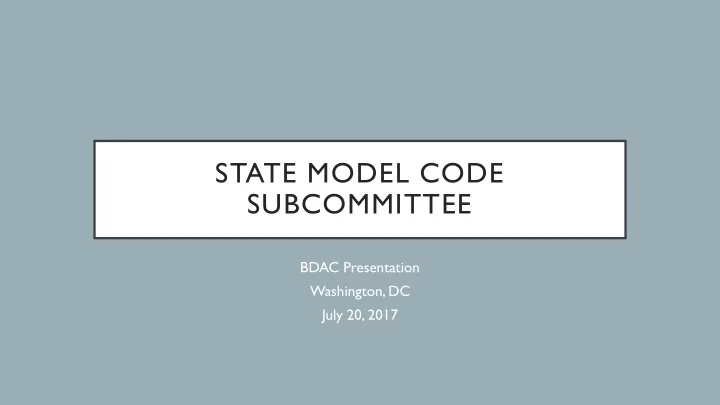

STATE MODEL CODE SUBCOMMITTEE BDAC Presentation Washington, DC July 20, 2017
SUBCOMMITTEE STRUCTURE • Established three working groups • Franchise Issues and Challenges • Issues of Standardization • Rural Deployment Hurdles and Strategies
GOALS FOR STATE MODEL CODE • Flexible & Modular • Allows for legislators, advocacy groups and other stakeholders to easily use the elements of the code that are needed for their specific situation • Adaptable & Thorough • Thorough enough to allow for extreme efficiency and influence, but simply enough to be applied in multiple ways • Agnostic & Transparent • No attempt to pursue nor promote a specific political or economic position
INTEGRATION WITH OTHER SUBCOMMITTEES • There will be overlap! And that’s okay. • Franchise Agreement – State vs Municipal • We’re providing a reference library to allow for all possible circumstances
CHALLENGE 1: FRANCHISE AGREEMENTS • Using the approach of a statewide franchise model, knowing that there will be other, local franchise codes written for our ‘library’ • The franchise serves as the vehicle through which we execute on the other two topic areas (Standardization and Rural) Statewide Issues of Rural Franchise Standardization Deployment Agreement
FRANCHISE AGREEMENTS: KEY PROVISIONS 1. Make Technology Neutral 2. Standardize Franchise Fees 3. Integrate Permitting Fees 4. Build Out Provisions 5. Customer Service Standards 6. Integration of Municipal Franchises
CHALLENGE II: STANDARDIZATION • Implementing state-level standards may allow for lower-cost and faster deployment as it reduces variability from city to city Statewide Issues of Rural Franchise Standardization Deployment Agreement
STANDARDIZATION: KEY PROVISIONS 1. Simplified Access to Rights of Way 2. Simplified Access to Poles, Ducts and Conduits 3. Simplified Access to Railroads Right of Way 4. Dig Once Provisions 5. Siting Procedures 6. Service Provider Shot Clocks 7. State and Municipal Shot Clocks
CHALLENGE III: RURAL DEPLOYMENT • We approached the state model code with a holistic, ‘whole-state’ approach, including urban, suburban and rural environments • Rural needs are different! Geographic and Economic/ROI issues require rural- specific approaches and incentives Statewide Issues of Rural Franchise Standardization Deployment Agreement
RURAL DEPLOYMENT: KEY PROVISIONS • The Standards set forth in Topic II will be bolstered with rural-specific requirements and elements that focus on rural needs • Designated rural communities are those with less than 100 people/non-water square mile outside of the county seat and lacking broadband access (25/3) • Key Provisions with a rural focus include: 1. Pole Attachment Pathways 8. Provider and Municipal Shot Clocks 2. One-Touch Make Ready 9. State Pre-Emptions of Approval Processes 3. One-Stop Permitting 10. Municipal Networks allowed for unserved rural 11. Stronger Enforcement of Adopted Policies 4. Dig Once Provisions 5. Railroad Right of Way Access 6. Allowance for Microtrenching 7. Siting Provisions
RURAL DEPLOYMENT: ECONOMIC INCENTIVES • Due to geographic and economic conditions, rural-specific standards may not be sufficient to attract private industry • Already-proven, limited-duration economic incentives states can utilize include: 1. Federal and/or State CAPEX Tax Deductions 2. Expansion of E-Rate funding to critical government and municipal locations 3. E-Rate Prioritization 4. Rural Utility Service Loans 5. State Authorized Investor Tax Credit 6. State Authorized Sales Tax Exemption 7. Allowance for Municipal-Owned Networks
NEXT STEPS • Integration of three topic areas into a modular, adaptable document • Draft Outline for Model Code: Introduction Article 4 : Working Together: State and • • Municipal Franchise Agreements Purpose • Article 5 : Standardization: Working • Impact Standards into Franchise Agreements • Urgency Article 6 : Rural Deployment: • • Requirements Guide on How to Use this Model Code • Article 7 : Rural Deployment: Special Article 1 : Scope/Purpose • • Considerations Article 2 : Definitions • Article 8 : Rural Deployment: Economic • and Other Incentives Article 3 : State-Wide Franchise • Agreements
THANK YOU • Chair: Kelly McGriff • Co-Chair: The Honorable Karen Charles Peterson • Group Lead, Franchise Agreements: Allen Bell Bridgette Daniel, David Don, Michael Hain, Ed Roach, Christopher Yoo • • Group Lead, Standardization: Heather Burnett Gold Scott Bergman, Doug Brake, Kelleigh Cole, Angie Dickson, Robert Pepper, • Karen Peterson, Michael Potter • Group Lead, Rural Challenges: Martin Yudkovitz Elizabeth Bowles, Jaime Fink, Carlos Gutierrez, Betsy Huber, Brian Mefford, Ken • Pfister, T om Sloan, T om Stroup, Brian Tagaban
ROLL TIDE!
Recommend
More recommend